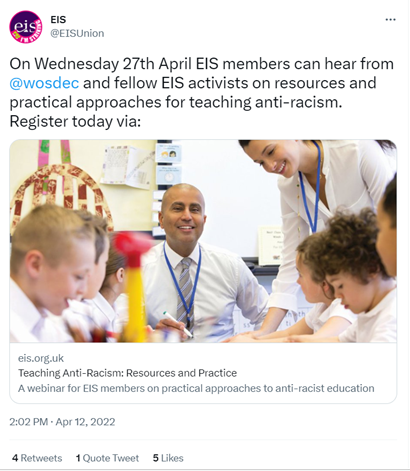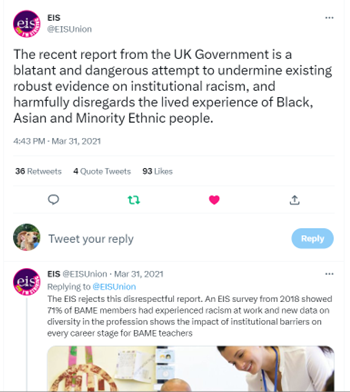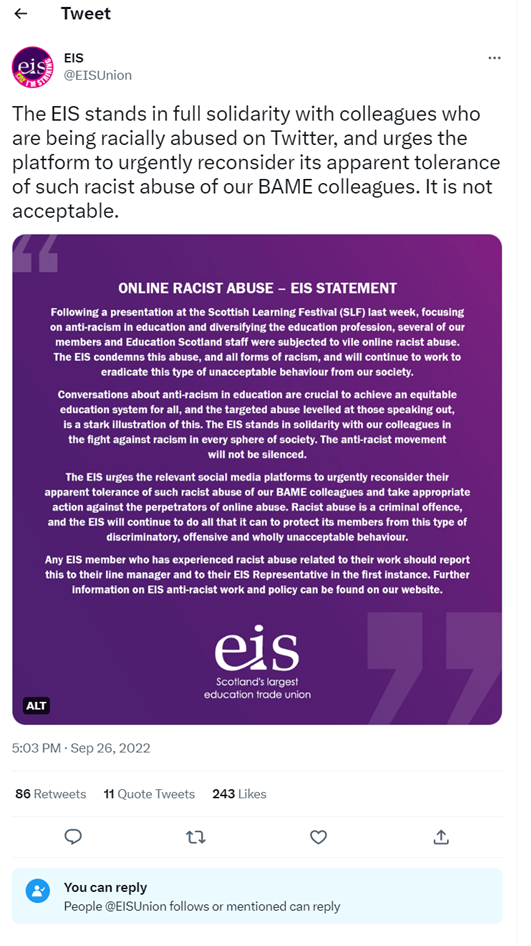Learning points
Reflective question:
How would you describe each of these social media posts? What do you think they are trying to achieve?
When planning a social media post, it is helpful to have a clear purpose in mind. Social media is incredibly saturated with content, so to make sure you are reaching the people you’d like to reach, be clear on what the aim of your content is.
Is it to raise awareness of an issue or perspective, to share information and gain participation, or to get people to do something?
Review your notes and reflections for a previous topic of learning that you have undertaken as part of this Module. How could you use social media to mobilise members for this topic?
We will be using the example of anti-racism.

Boosting engagement
Social media are not broadcasting tools – they are conversations, so make sure your intended audience can engage and ‘stay’ with your content for longer, by asking something of them. Create content that is shareable, such as videos or visual statements, as this makes it easier to use others’ engagement to boost your reach.
When it comes to some platforms, such as X (formerly known as Twitter), you may want to limit engagement to only your followers. This is in order to minimise disruption from possible online ‘trolls’, who frequently target equality0related content.
Timing is key. Social media moves in real-time and is oversaturated with content. Posting at peak times puts your content at the top of people’s screens – just after work is often optimal. Timing your content to link into existing campaigns/focus, certain commemoration days such UN Anti-racism day, or in response to a particular issue that is ‘live’ in the public’s mind will also help with engagement. Look at the engagement on the post below, as opposed to the examples above. What are the factors that may have made this post more successful, than the previous ones?

Purpose of a post
A social media post can work to multiple purposes. For example, if your local area is in the process of setting up a BAME Network, a post reaching out to BAME members can also be a way to raise awareness of the importance of diversity in the teaching profession.
A post can be a call to action, or invite engagement through asking a question of members. Interactive posts can be very effective in identifying individuals who may want to become more involved, and can make union structures appear more accessible.
In some cases, it is important to respond directly to a topic, and issue a statement with a clear position. For example, issuing a statement reaffirming EIS policy position. In other cases, it can be just as meaningful to provide a counter-narrative, and work to shift the discourse.

In the example to the right, the EIS responds to online racism that was targeting conversations about diversifying the teaching profession. The coordinated, online attacks came after members of the Scottish Government’s Diversity in the Teaching Profession and Education Workforce Subgroup, which the EIS chairs, hosted a Scottish Learning Festival Event titled “You Can’t be What You Can’t See”, discussing ways to attract and retain more Black, Asian and Minority Ethnic teachers. The EIS Education and Equality Department reached out to EIS members affected to offer our support, recognising the impact on their mental health and wellbeing.
Our external communication strategy was two-fold; to issue a public and formal statement relaying our position, and to issue a series of counter-narrative messages.
Reflective question:
Who do you think is likely to engage with these social media posts?
Can you identify the possible purposes and messages within these posts?

Format and language
Ensure the language used for social media content is accessible, but still professional and coherent. It can be tempting to use more conversational language online, however this can often be a source of misunderstandings in relation to tone and intent, especially when responding to others. Ensuring you are constructing your communication as you would a written text, may help.
Remember also that actions speak louder than words. Include information about what you are doing, or what you are encouraging others to do within your posts. Beyond the information in the social media post, what are the next steps?
Plan and prepare for responses
You never know what responses you will get to a social media post, but it can be helpful to prepare some thinking around likely replies. If you expect a post to get some unhelpful push-back (rather than constructive criticism) or instigate emotional discussion, consider how you can facilitate this offline or signpost to other resources. There is seldom much to be gained from arguing with strangers on the internet, but it can be essential when this happens to signal support and standing up for equality. One way to avoid abusive responses is by restricting your posts to be shown to followers only, and to block/report any abuse.
Make sure you put the right expectations in place – will you be monitoring X regularly? If not, say that clearly within your online profile or within your post.
Remember that members will have different comfort levels and digital literacy levels. Make sure that you are deliberate therefore in what is put online, and offer meaningful engagement in spaces where care and support can be more easily facilitated, such as at a member meeting. Social media cannot fully replace emails and even posters. Many members will not be on social media.
Also – don’t forget to take a breather. It can be incredibly easy to get swept up into the speed of the stream of online communication and to make assumptions about others behind a screen. However, it is rarely necessary to respond immediately, and sometimes not necessary to respond at all if you do not believe anything constructive will arise from it. Consider putting out a holding message saying you will consider responding once you have had time to review the comment. Just because something is online does not mean you have to respond. Seek support if you are unsure of how to respond in line with EIS policy, or if you are concerned for someone’s wellbeing – including your own.
Is there anything else that you would add to this?
Online safeguarding
Hopefully, your social media posts will be used only for its intended purposes, and mobilise members for social justice action! Unfortunately, sometimes issues occur online, and equality related topics may possibly attract negative online attention and in some cases, harassment. If this happens, you can block individuals (ensure you do not block constructive criticism and comment from members, but absolutely block any and all abuse), and you can also report tweets. Report tweets.
On X, you can make your account Private (even temporarily) and select the option “Change who can reply” on posts. You can also mute conversations.
Online hate crime should be reported to the police, and contributes to hate crime data. Unfortunately, police are rarely able to track offenders due to the prevalence of fake accounts. If a member is the victim of online abuse, they should be supported in reporting (if they wish to do so) and take care of their mental health and wellbeing.
If you are creating social media posts on behalf of the EIS, remember to ensure that this is in line with EIS policy and that you have the clearance of your local branch/association.
Reflective question:
Consider equality related trauma (we cover the experience of racial trauma in Topic 5).
How will your understanding of the impact of discrimination inform how you post about your chosen equality topic?
Are there steps you would like to take before constructing your post?